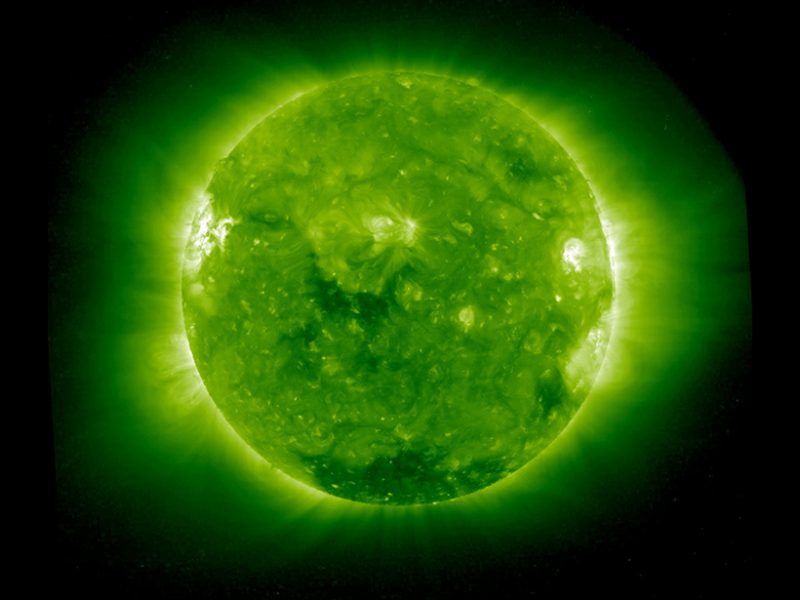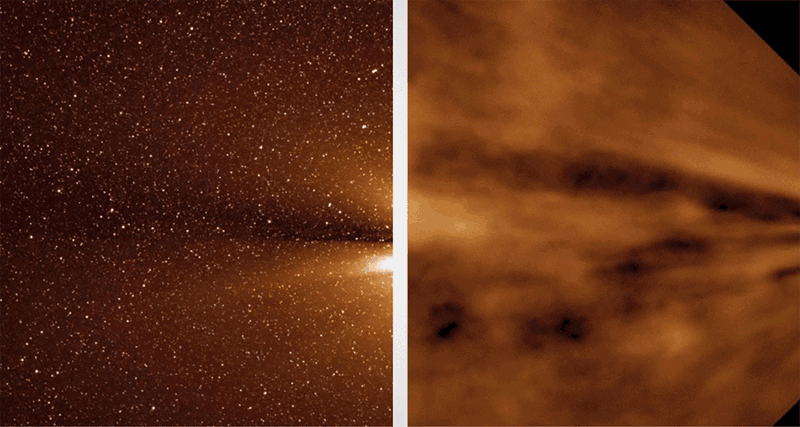Using computer-processed images from Sun-watching satellites, scientists observed solar wind emerging from the Sun's corona.

An extreme ultraviolet light image of the Sun and its corona from NASA’s Solar Terrestrial Relations Observatory (STEREO). Credit: NASA/STEREO
By JoAnna Wendel 9 September 2016
What does solar wind look like when it first forms from the Sun’s corona? Now, with new satellite images manipulated to remove background light, scientists can answer that question.
“This is part of the last major connection we need to make to understand how [the Sun] influences the environment around the Earth,” Craig DeForest, an astrophysicist at the Southwest Research Institute in Boulder, Colo., told Eos. DeForest is the lead author on a new paper describing the novel technique, published last week in the Astrophysical Journal.
A Tricky Search
Back in the 1960s, scientists discovered the solar wind, a constant flow from the Sun of extremely high temperature plasma that’s so hot the Sun’s gravity can’t hold it. Scientists knew that the solar wind was somehow connected to the Sun’s corona—the bright layer of the Sun’s atmosphere that can be seen during a solar eclipse—but until now, scientists weren’t sure how one transitioned into the other.
This transition is important because “we’re trying to understand, among other things, why the solar wind near the Earth is variable and gusty,” DeForest said. This gustiness can affect things like the trajectory of coronal mass ejections—huge magnetic explosions from that Sun that, when they hit Earth, can knock out telecommunications, short out satellite circuitry, and damage electrical transmission lines.
But studying the transition between the corona and the solar wind is difficult—the solar wind is very faint against a background full of stars and interplanetary dust, DeForest said, making it hard to discern exactly what is happening as the solar wind gets created.
When scientists looked at previous images and “saw the [corona] fade, it was difficult to tell whether it was fading in an absolute sense or dropping below stellar background,” DeForest continued.
Unfixing the View
With computer-processed images from NASA’s Solar Terrestrial Relations Observatory (STEREO), the scientists finally observed this transition. The processing removed objects of “fixed brightness,” DeForest said, like the dust cloud that fills the inner solar system and the background stars themselves. That left the moving and variable features of the solar wind itself.

Two views of the solar wind: STEREO’s images (left) before computer processing and (right) after processing. Scientists used an algorithm to dim the light coming from the background star field. Credit: NASA/STEREO, data from Craig DeForest, SwRI
Scientists already knew that masses of particles in the corona are controlled by magnetic fields, which gives the Sun its “rays”—similar to those in a child’s drawing, DeForest said. The new images revealed the farthest reaches of the magnetically controlled corona, showing that once the material travels about a third of the distance from the Sun to the Earth, the magnetic fields weaken enough that solar wind particles can disperse from the field lines and fan out more like an Earthly wind.
The video below, from NASA, compares this transformation of the solar wind from rays to dispersed particles to the way water shoots from a water gun or hose: Closer to the water gun, the water is one mass, but as it moves farther from the gun, it disperses into a spray of individual droplets.
Investigating this transition region will help scientists to predict the arrival and strength of the Sun’s outbursts— Earth-bound coronal mass ejections—after they pass through a full astronomical unit of the existing solar wind, DeForest said.
—JoAnna Wendel, Staff Writer
Citation: Wendel, J. (2016), Scientists get first glimpse of solar wind as it forms, Eos, 97, doi:10.1029/2016EO059053. Published on 09 September 2016.
© 2016. The authors. CC BY-NC-ND 3.0
